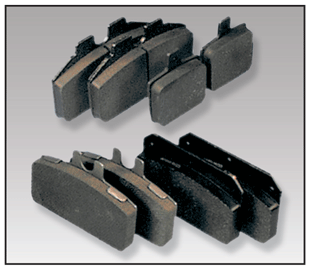Toll Free: 1-866-508-6394
OR Contact Us
OR Contact Us
Shop by Category
There are a different set of demands placed on braking systems, be they used for daily driving on the street or in competition. Oval track and road racing vehicles are concerned with slowing down for corners and repeating the cycle frequently. Drag racers, on the other hand, are primarily focused on holding their cars on the starting line prior to launching, then braking hard at the end of a run. Sure, there are things like swept area, clamping force, and cooling to contend with…but it’s the brake linings that are at the heart of the action. And there certainly are a number of choices out there. Today, the ultimate brake lining material is carbon fiber. Unlike other materials, which are negatively affected by heat and will fade, carbon fiber responds positively to the heat and the level of friction actually increases as they get hotter. As a point of interest, in the process of applying pressure a portion of the lining material is transferred to the rotor, which builds the friction between the two. The carbon material cannot efficiently transfer to a steel rotor, hence it is imperative that the rotors are also made of carbon fiber. That’s why you’ll see these braking systems referred to as “carbon/carbon.” In addition to performing exceptionally well in high heat, severe stopping environments, carbon/carbon brakes are much lighter than their steel counterparts. Of course, they’re also quite a bit more expensive. The majority of drag racing vehicles have brakes with steel rotors. So then one must determine the optimum lining for their particular application. These will range from “soft” to “hard” linings, as well as the middle ground. “Soft” (non-metallic or “organic”) linings typically are a composition of glass, rubber, Kevlar and resins and they grip really well, but also wear out fairly quickly. On the other end of the spectrum are “metallic” linings that commonly feature a composition of iron, copper, steel and graphite. These “hard” linings last far longer than their “soft” counterparts, but also take their toll on the rotors as they require more heat to obtain the necessary friction. It’s not uncommon to find it necessary to change rotors when the linings are replaced.  Mark Williams Enterprises recommends Ferodo High Friction non-asbestos linings for most applications. This is a semi-metallic lining that has excellent stopping power and heat control and provides the best balance of performance and durability. M-W technicians say that racers have tried other brands of semi-metallic linings but come back to the Ferodos, as their composition seems to work the best. How often should linings be changed? The common rule of thumb employed by Williams is to recommend changing linings when 50% of the pad is worn. Be sure and verify rotor flatness, too. And it’s always a good bet to check line pressure (1,000 psi normal, 1,200 psi for severe stopping). You should also be aware of the fact that all of these setups are designed for straight-line drag racing applications. For street use, where side loading the bearings is commonplace, M-W offers a tapered roller bearing setup that far exceeds the radial capacity of OEM ball and roller bearings, plus can take thrust in either direction. Getting the best possible axle bearings for your application will pay dividends in performance and dependability.
|